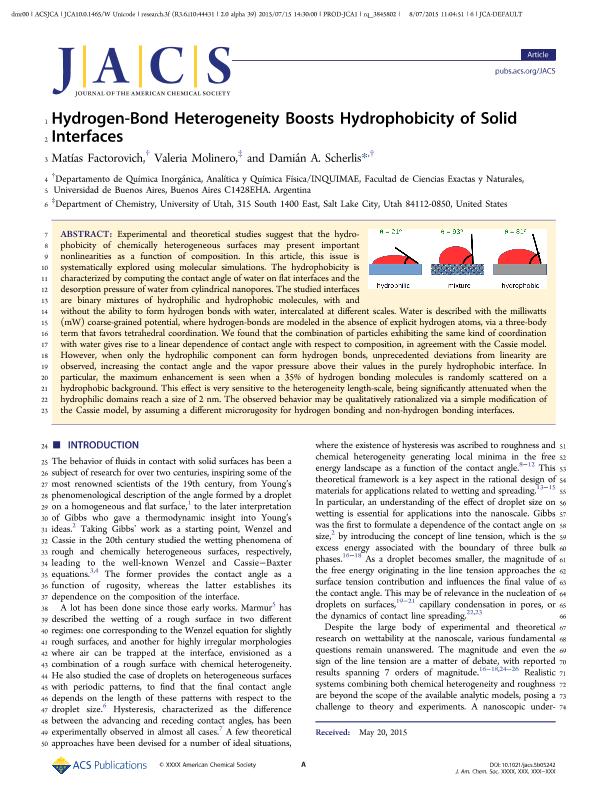Mostrar el registro sencillo del ítem
dc.contributor.author
Factorovich, Matias Hector

dc.contributor.author
Molinero, Valeria
dc.contributor.author
Scherlis Perel, Damian Ariel

dc.date.available
2018-09-10T16:49:32Z
dc.date.issued
2015-08
dc.identifier.citation
Factorovich, Matias Hector; Molinero, Valeria; Scherlis Perel, Damian Ariel; Hydrogen-Bond Heterogeneity Boosts Hydrophobicity of Solid Interfaces; American Chemical Society; Journal of the American Chemical Society; 137; 33; 8-2015; 10618-10623
dc.identifier.issn
0002-7863
dc.identifier.uri
http://hdl.handle.net/11336/58906
dc.description.abstract
Experimental and theoretical studies suggest that the hydrophobicity of chemically heterogeneous surfaces may present important nonlinearities as a function of composition. In this article, this issue is systematically explored using molecular simulations. The hydrophobicity is characterized by computing the contact angle of water on flat interfaces and the desorption pressure of water from cylindrical nanopores. The studied interfaces are binary mixtures of hydrophilic and hydrophobic sites, with and without the ability to form hydrogen bonds with water, intercalated at different scales. Water is described with the mW coarse-grained potential, where hydrogen-bonds are modeled in the absence of explicit hydrogen atoms, via a three-body term that favors tetrahedral coordination. We found that the combination of particles exhibiting the same kind of coordination with water gives rise to a linear dependence of contact angle with respect to composition, in agreement with the Cassie model. However, when only the hydrophilic component can form hydrogen bonds, unprecedented deviations from linearity are observed, increasing the contact angle and the vapor pressure above their values in the purely hydrophobic interface. In particular, the maximum enhancement is seen when a 35% of hydrogen bonding molecules is randomly scattered on a hydrophobic background. This effect is very sensitive to the heterogeneity length-scale, being significantly attenuated when the hydrophilic domains reach a size of 2 nm. The observed behavior may be qualitatively rationalized via a simple modification of the Cassie model, by assuming a different microrugosity for hydrogen bonding and non-hydrogen bonding interfaces.
dc.format
application/pdf
dc.language.iso
eng
dc.publisher
American Chemical Society

dc.rights
info:eu-repo/semantics/openAccess
dc.rights.uri
https://creativecommons.org/licenses/by-nc-sa/2.5/ar/
dc.subject
Contact Angle
dc.subject
Nanodroplet
dc.subject
Molecular Dynamics
dc.subject
Interfaces
dc.subject.classification
Otras Ciencias Químicas

dc.subject.classification
Ciencias Químicas

dc.subject.classification
CIENCIAS NATURALES Y EXACTAS

dc.title
Hydrogen-Bond Heterogeneity Boosts Hydrophobicity of Solid Interfaces
dc.type
info:eu-repo/semantics/article
dc.type
info:ar-repo/semantics/artículo
dc.type
info:eu-repo/semantics/publishedVersion
dc.date.updated
2018-09-04T19:05:02Z
dc.journal.volume
137
dc.journal.number
33
dc.journal.pagination
10618-10623
dc.journal.pais
Estados Unidos

dc.journal.ciudad
Washington
dc.description.fil
Fil: Factorovich, Matias Hector. Consejo Nacional de Investigaciones Científicas y Técnicas. Oficina de Coordinación Administrativa Ciudad Universitaria. Instituto de Química, Física de los Materiales, Medioambiente y Energía. Universidad de Buenos Aires. Facultad de Ciencias Exactas y Naturales. Instituto de Química, Física de los Materiales, Medioambiente y Energía; Argentina. Universidad de Buenos Aires. Facultad de Ciencias Exactas y Naturales. Departamento de Química Inorgánica, Analítica y Química Física; Argentina
dc.description.fil
Fil: Molinero, Valeria. University of Utah; Estados Unidos
dc.description.fil
Fil: Scherlis Perel, Damian Ariel. Consejo Nacional de Investigaciones Científicas y Técnicas. Oficina de Coordinación Administrativa Ciudad Universitaria. Instituto de Química, Física de los Materiales, Medioambiente y Energía. Universidad de Buenos Aires. Facultad de Ciencias Exactas y Naturales. Instituto de Química, Física de los Materiales, Medioambiente y Energía; Argentina. Universidad de Buenos Aires. Facultad de Ciencias Exactas y Naturales. Departamento de Química Inorgánica, Analítica y Química Física; Argentina
dc.journal.title
Journal of the American Chemical Society

dc.relation.alternativeid
info:eu-repo/semantics/altIdentifier/doi/https://dx.doi.org/10.1021/jacs.5b05242
dc.relation.alternativeid
info:eu-repo/semantics/altIdentifier/url/https://pubs.acs.org/doi/10.1021/jacs.5b05242
Archivos asociados
